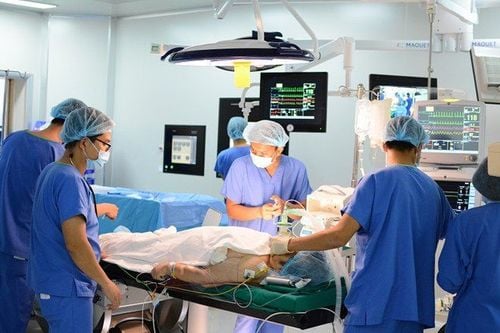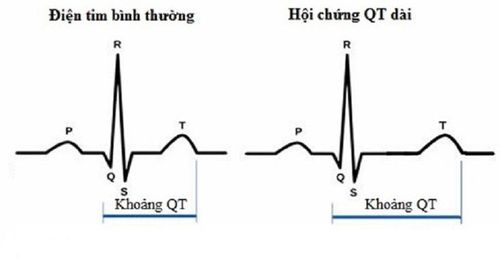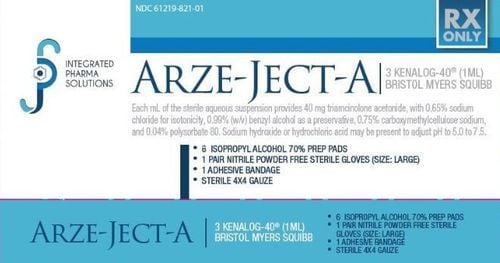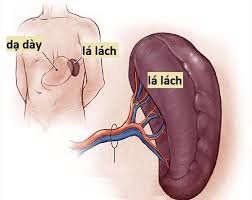This is an automatically translated article.
The article was professionally consulted with Specialist Doctor II Nguyen Quoc Viet - Interventional Cardiologist - Department of Medical Examination & Internal Medicine - Vinmec Danang International General Hospital.The article was professionally consulted by Dr. Nguyen Quoc Viet - Cardiologist and Cardiovascular Interventionist, Vinmec Danang International General Hospital.
Aortic stenosis is a dangerous heart valve disease with a high incidence, especially in the elderly. What causes aortic valve stenosis? How to vet? The following article will help you better understand this disease.
1. What is aortic valve stenosis?
Aortic stenosis is a blockage of the ejection of the left ventricle due to a decrease in the orifice of the valve. Aortic stenosis accounts for a quarter of patients with valvular heart disease and 80% of patients are male.
2. Causes of aortic valve stenosis
Aortic stenosis can occur in the following situations: after rheumatic heart disease, gradual valve calcification in people with congenital aortic valve disease or in the elderly.
Aortic valve stenosis due to rheumatic heart disease: common in Vietnam. The leaflets are thickened, especially at the valve margin, with fibrosis, calcification, the leaflets entering the aortic valve margin. Often associated with aortic regurgitation or mitral valve disease such as mitral stenosis, mitral regurgitation, mitral regurgitation,... Aortic stenosis due to degeneration and calcification: common in the elderly. Often associated with calcium metabolism disorders and/or risk factors for atherosclerotic disease such as old age, male sex, diabetes, hypertension, dyslipidemia, smoking,... Narrow Congenital aortic valve: The most common form in adults is mitral aortic valve disease, accounting for 1-2% of the population, mainly in men. The aortic valve often degenerates and calcifies prematurely.
3. Symptoms of aortic valve stenosis

Symptoms often appear when the aortic valve stenosis is severe (when the aortic valve area is only 1/3 of the normal person). The three most common symptoms are chest pain, fainting, and shortness of breath.
Chest pain: often appears late. Due to an imbalance between myocardial oxygen supply and demand (left ventricular hypertrophy increases myocardial oxygen demand, while myocardial perfusion decreases due to increased wall stress on the arteries and due to decreased intraarterial pressure). motherboard). In addition, about 20% have coronary artery disease associated with angina attacks. Exercise-related pain (appears on exertion, decreases with rest). Syncope or other signs such as visual disturbances, loss of balance, dizziness: encountered in 15-30% of cases. It may be due to ventricular arrhythmias, sudden left ventricular failure during exercise, or peripheral vasodilatation by a pressure reflex mechanism. Dyspnea: in the early stage, dyspnea is mainly due to diastolic failure, in the late stage, dyspnea is caused by both diastolic and systolic failure. Initially dyspnea on exertion, then nocturnal dyspnea episodes, acute respiratory attacks (cardiac asthma attacks, acute pulmonary edema). Acute left-sided heart failure may be due to new-onset atrial fibrillation. It should be noted that the symptoms are often delayed and are a poor prognostic factor.
4. How is aortic valve stenosis treated?
Medical treatment for patients with no indication for surgery: very limited effectiveness and only for heart failure, pulmonary congestion Percutaneous balloon aortic angioplasty: poor long-term outcome (easy to narrow) (again) should be done only when: Congenital aortic stenosis Patient is severe, unwell or rheumatic in a young patient When there are other serious comorbidities that do not allow valve replacement Surgery Patient has an indication for first-degree surgery other disease and require angioplasty. Surgery: For patients with tight aortic valve stenosis, calcified valve, who have clinical symptoms, in adulthood, aortic valve replacement surgery is an effective maintenance treatment. Valve options include: Ross surgery (autologous valve transplant) Allograft aortic valve replacement Biological (differentiated) valve replacement Mechanical valve replacement.
5. Why should percutaneous aortic valve replacement (TAVI) be used?

Previously, surgery to replace the aortic valve was the only method to improve the patient's condition and reduce the mortality rate for patients. However, this method is not suitable for elderly patients with weak health or comorbid cardiovascular diseases. Therefore, percutaneous aortic valve replacement (TAVI) was born, becoming the optimal solution for people with aortic stenosis.
This technique has been officially and routinely applied for about 10 years now. Vinmec International General Hospital is the first hospital in Vietnam to perform this technique independently.
Percutaneous aortic valve replacement (TAVI) has the following technical advantages:
Less invasive, gentler and simpler than conventional aortic valve replacement surgery. Doctors do not need to cut along the patient's sternum, do not have to run an artificial cardiopulmonary bypass machine, do not have general anesthesia, so the risk of complications is minimized. Reduce postoperative time as well as shorten hospital stay. High success rate. This is a lifesaver for patients who cannot tolerate surgery because of old age, weakness or chronic medical conditions. TAVI technique should be performed at Vinmec because:
Vinmec is the only place in Vietnam equipped with a Hybrid room that can perform difficult and complex techniques, modern equipment brings image quality. best for wizards. As the only place in Vietnam awarded the certificate of "independent aortic valve replacement" in Vietnam, and Prof. Vo Thanh Nhan is the first interventional cardiologist to be awarded the "Proctor" certificate in Vietnam. There is a team of "cardiology team" that work in unison and support, Cardiology surgeons are always accompanies during the procedure.
Please dial HOTLINE for more information or register for an appointment HERE. Download MyVinmec app to make appointments faster and to manage your bookings easily.














